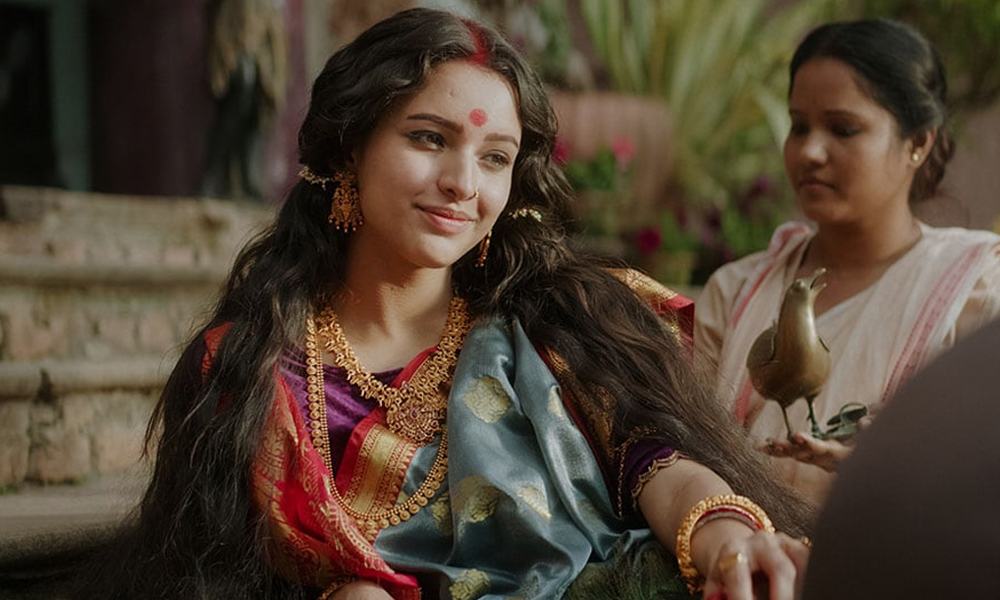
Image Credit: The Indian Express
Netflix's 'Bulbbul' Is The Witch That Sits Cross-Legged On A Bedecked Armchair & Terrorizes Patriarchy
India, 26 Jun 2020 11:41 AM GMT
Editor : Navya Singh |
Navya writes and speaks about matters that often do not come out or doesn’t see daylight. Defense and economy of the country is of special interest to her and a lot of her content revolves around that.
Creatives : Abhishek M
" An engineer by profession, Abhishek is the creative producer of the team, graphic designing is his passion and travelling his get away. In more ways than one, he makes the content visually appealing."
Bulbbul showed us how a witch can be a woman who smiles confidently, looks you right in the eye when she talks, says the right things, does what society wrongfully asks her not to do, wears beautiful sarees that we often see Tagore's heroines wear, and a bright red bindi underneath which lies the third eye of Goddess Durga.
A typical haveli that we often read about in Rabindranath Tagore's stories usually houses secrets that are carefully confined in the paan boxes, lathis that the elderly in the house use and the deceiving grins of the aristocratic men and the submissive smiles of the women of the house.
The year 1881 is almost half a century before the first law banning child marriage came into effect. Bulbbul, an ever-smiling, carefree, happy little girl of about five, is married off to a man much older than her. Although Bado Thakur is the husband she should bow down to, Bulbbul bonds with Bado Thakur's brother, Satya - perhaps because they were nearly the same age.
Bulbbul and Satya spend time in the almost-spooky, huge Thakur Badi telling stories of witches and witchcraft to each other.
The other members of the house comprise Bado Thaku's brother, and sister-in-law Binodini, who has given in to the societal structure that let men crush women under their feet.
When Bulbbul is being decked up for her marriage, she is told that she has to wear a toe ring as it is keeps women under control.
Bulbbul was a young woman who refused to give in to the orthodox culture of society. She liked to run around the haveli, sit on a swing and let the breeze pass through her hair, and chuckle at the excitement she found in climbing trees.
Twenty years later, Satya is sent off to London to study. The larger motive, however, was to separate him from Bulbbul.
Bado Thakur is now at peace, however, the solace could only grip him after he had punished Bulbbul for breaking the chains that patriarchy had bound her with. He beat her till she could hardly walk.
Days later, when she is still bedridden, Bulbbul is brutally raped by Bado Thakur's brother.
The secrets obviously lay buried in the closets, wrapped up in the ladies' beautiful sarees and quietly shut inside Binodini's paan box.
Satya comes back to the haveli five years later to find that Bado Thakur had long left the house. Binodini is now a widow as her huaband has been killed by the witch over whose stories Sayta and Bulbbul had bonded years back.
Satya finds that Bulbbul's coy smile has now changed into a confident grin. Her modest comments had almost become sarcastic remarks that hit you right in the heart.
Behind the bright eyes beautifully smeared with kajal, and the radiant red bindi on her forehead, Bulbbul is now the kind of woman that patriarchy for years has tried to crush.
A series of murders have shaken the town. Surprisingly, men who are being killed are those who oppress women. The whole town talks under their breath about the witch that is on the loose.
Unfortunate as it is, folklore and fairy tales and fables have described a witch as a wicked woman with evil intentions. She looks scary, commits crimes and gets away with it.
Bulbbul showed us how a witch can be a woman who smiles confidently, looks you right in the eye when she talks, says the right things, does what society wrongfully asks her not to do, wears beautiful sarees that we often see Tagore's heroines wear, and a bright red bindi underneath which lies the third eye of Goddess Durga.
The bloodthirsty 'chudail with ultey pair' is a woman who was wronged. She has now learnt to break the shackles of male domination, sit cross-legged on a bedecked armchair and put a cigar to her lips.
Bulbbul represents every woman who has refused to be oppressed. Bulbbul represents every woman who has stood up against rape and violence.
Bulbbul is the ideal witch of our fairy tales. She is the witch that our male-dominant system is terrorized of.
Bulbbul is the woman that patriarchy has never been able to tyrannize.
Produced by Anushka Sharma and Karnesh Sharma, and written and directed by Anvita Dutt, Netflix's Bulbbul is a supernatural drama film that will make you stop and introspect.
Right before the festive season of Durga Puja, you will see an ocean of kaash phool (a kind of white flower) growing in Kolkata on lands that are not cared for. As Bulbbul ends, we see kaash phool growing along the courtyard of the once brilliant, luminescent haveli - the same courtyard where Bulbbul's footsteps had once echoed and where her innocent giggle had once rung in the air.
The haveli now looks deserted and cursed.
Perhaps, this is the kind of abandonment that gives rise to a new, bright beginning in a world so vicious and unjust.
 All section
All section














